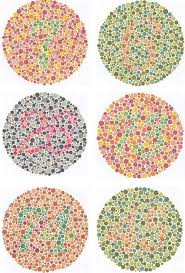In 1803 John Dalton was the first scientist to take academic interest in the subject of color blindness. His interest stemmed from he and his brother being color blind. John Dalton postulated that shortage in the color perception was caused by discoloration of the liquid medium of the eyeball called aqueous humor. According to his research he believed that the aqueous humor was bluish and therefore filtered out all of the colors. Through his lifetime John Dalton became a well known, respectable chemist and physicist. He was one of the early proponents of Atomic theory. One of his last wills was to get a autopsy of his eyes after death. Unfortunately there wasn’t any bluish liquid found.

Later it was discovered that there are three types of cone cells and each type has a different sensitivity to light wavelengths. One type of cone perceives blue light, another perceives green and the third perceives red. When you look at an object, light enters your eye and stimulates the cone cells. Your brain then interprets the signals from the cones cells so that you can see the color of the object. The red, green and blue cones all work together allowing you to see the whole spectrum of colors. For example, when the red and blue cones are simulated in a certain way you will see the color purple.
Inherited color blindness happens when you don’t have one of these types of cone cells or they don’t work properly. You may not see one of the three basic colors, or you may see a different shade of that color or a different color. This type of color vision problem doesn’t change over time. Click here to see the different variations of color blindness.
Today over 2.7 million people are color blind. 8% of all men are suffering from the condition as well as 0.5% of women. Color blindness is usually genetic. The red/green and blue color blindness is usually passed down from the parents, the gene responsible for this is carried on the X chromosome. The vast majority inherited their condition from their mother who is normally a ‘carrier’ but not color blind herself. If a woman is red-green color blind all of her sons will be as well. However some people acquire color blindness from long-standing diseases.
Nearly all people who are “color blind” can see colors but have difficulty distinguishing between certain colors. Not all people who are color blind have trouble with the same colors, most cannot distinguish between reds and greens in dim light, some cannot separate blues from yellow, and a very small group have a condition called monochromatism which only allows them to see black and white.
Dr. Harry Zeltzer BS. OD. graduated with honors from Massachusetts college of optometry in 1952. He is the inventor of X chrom contact lens. The X chrom lens is a monocular corneal contact lens which significantly enhances color perception for those with color deficiency. The contact is worn only in the non dominant eye. Today the lens is a soft lens that has a small magenta circle in the pupil area that intensifies the color of the red and green objects. This does not cure vision problems it only aids in the perception of seeing colors. The X chrom lens is available in plano and prescription. X chrom lens fits the pupil without compromising the color of the eye or visual acuity.

Our own Dr. Wilson has experience fitting the X chrom contact lens. So if you know someone who is interested in finding out more about the options available for Red/Green color blindness please direct them our way!
Please call Bond Eye Associates to schedule your yearly health vision exam with confidence knowing that they have been a trusted, locally owned, medical practice for over 40 years. They are accepting new patients in both of their locations: Peoria and Pekin, IL. Please call 309-692-2020 or fill out our contact us form to schedule an appointment.


